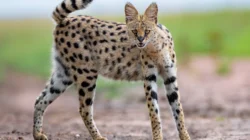LOGIC.co.id – The caracal cat (Caracal caracal) is one of the most fascinating and mysterious wild cats in the world. Known for its striking appearance with tufted ears and incredible jumping ability, the caracal is a nimble predator with an important role in its ecosystem. While its population is considered stable in some regions, the caracal faces significant threats from illegal hunting, habitat loss, and human conflict. This article delves deeper into the caracal cat, from its physical features and behavior to the challenges it faces in survival.
Physical Features of the Caracal Cat
The caracal cat is a predator with a sleek and muscular body that allows it to move swiftly and with remarkable agility. Here are some key physical characteristics of the caracal:
-
Size and Weight Caracals are medium to large-sized cats, with body lengths ranging from 60 to 105 cm and a tail length of 20 to 30 cm. Males tend to be larger than females, with males weighing up to 20 kg, while females generally weigh between 8 and 16 kg. Though not as large as lions or tigers, caracals have a well-proportioned body with strong muscles, making them efficient hunters.
-
Tufted Ears One of the most distinctive features of the caracal is its large, tufted ears. These ears can rotate 180 degrees to detect sounds in its environment, especially to capture the faint noises of approaching prey. The tufts at the tips of the ears also serve as a keen auditory tool and are used for social signaling, helping caracals communicate with each other.
-
Coat and Color Caracals are covered with short, dense fur that is typically reddish-brown or golden, which helps them blend into their natural habitats. Their bellies and the insides of their legs are usually lighter in color, creating a contrast with the darker upper body. Some individuals may have darker or lighter fur, depending on their specific habitat.
-
Sharp Eyesight and Acute Sense of Smell Caracal eyes are almond-shaped and can range from golden to blue-green. Their vision is highly developed, especially in low-light conditions, as they are nocturnal animals. This sharp vision allows them to be effective hunters during the evening and nighttime. Additionally, caracals have a keen sense of smell, which helps them track prey with great precision.

Habitat and Distribution of the Caracal Cat
Caracals can be found in various regions across Africa, the Middle East, and parts of Asia. They inhabit a range of environments, from open savannahs, shrublands, and rocky areas to desert regions. Caracals generally avoid dense forests, preferring areas with more open vegetation that allow for easier hunting.
Countries where caracals are commonly found include:
- Sub-Saharan Africa: Caracals are widespread across most of Africa, with the highest concentrations in the northern and eastern parts of the continent.
- Western Asia: These cats can also be found in the Middle East, including countries like Turkey, Iran, and Pakistan.
- India: Though less common, caracals are also found in some parts of India, though their population is more fragmented.
Behavior and Habits of the Caracal Cat
-
Agile Predator Caracals are known for their efficiency as hunters. They are primarily nocturnal, relying on their sharp vision and ability to conceal themselves. Caracals are adept at hunting small mammals like rabbits, rodents, and birds. They can leap up to 3 meters to catch birds in flight, using their speed and agility to chase down prey.
-
Solitary Behavior Caracals are solitary animals, meaning they prefer to live and hunt alone. However, they maintain a territorial range that they defend against other individuals, especially during the mating season. They often mark their territory with scent marks or feces on prominent rocks or trees.
-
Communication Through Sound Caracals communicate with each other using a variety of vocalizations, including growls, hisses, and soft calls that are often used by females to attract males. They also rely on body language and other visual cues, such as ear and tail positions, to convey messages to other caracals.
-
Jumping Ability and Hunting Skills One of the most impressive skills of the caracal is its ability to jump high. They can leap up to 3 meters to catch low-flying birds. Caracals typically hunt by ambushing or surprising their prey with sudden, powerful jumps directly at their target.
Reproduction and Life Cycle of the Caracal Cat
Caracals breed throughout the year, though their peak mating season occurs between March and June. Females typically give birth to 1 to 6 kittens after a gestation period of 70 to 78 days. The kittens are born in a safe place, such as a cave or dense brush, and are dependent on their mother for the first few months of their lives.
Caracal kittens open their eyes at around 10 days of age and begin learning to hunt at around 4 to 6 months. They remain with their mother until they are about one year old before becoming independent and establishing their own territory.
Threats and Conservation of the Caracal Cat
Caracals face numerous threats, both natural and human-made. Some of the major threats to the caracal include:
-
Hunting and Human Conflict Caracals are often seen as a threat to livestock or game farms, even though most of their diet consists of small mammals and birds. This leads to conflicts with humans, resulting in illegal hunting and trapping.
-
Habitat Loss Urbanization, agriculture, and land clearing for settlements are significant threats to the caracal’s natural habitat. Habitat loss leads to fragmented populations and a reduced area for hunting.
-
Illegal Wildlife Trade Caracals are also vulnerable to the illegal wildlife trade, where they are captured and sold as exotic pets. While caracals are not suitable for domestication, this trade contributes to their decline in the wild.
-
Conservation and Protection Efforts Although caracals are not listed as endangered by the International Union for Conservation of Nature (IUCN), some local populations are declining. Conservation organizations are working to raise awareness about the importance of preserving caracal habitats and preventing illegal hunting.
Interesting Facts About the Caracal Cat
- Caracals are known for their ability to leap and catch birds in flight. They can jump as high as 3 meters, a skill that is crucial for capturing their prey.
- Despite being sometimes kept as exotic pets, caracals are not suitable for domestic life due to their high space and hunting needs.
- In some cultures, the caracal is revered as a symbol of strength and beauty. Ancient Egyptian art often depicted the caracal as a creature of power and grace.
Conclusion
The caracal cat is one of the most fascinating and graceful predators in the animal kingdom. Its elegance and hunting prowess make it a remarkable creature, yet it faces significant challenges in the wild. While not currently classified as endangered, the caracal’s survival is threatened by human activities, including habitat destruction and illegal hunting. By raising awareness and supporting conservation efforts, we can help ensure that future generations will continue to admire the beauty and strength of the caracal in its natural habitat.











